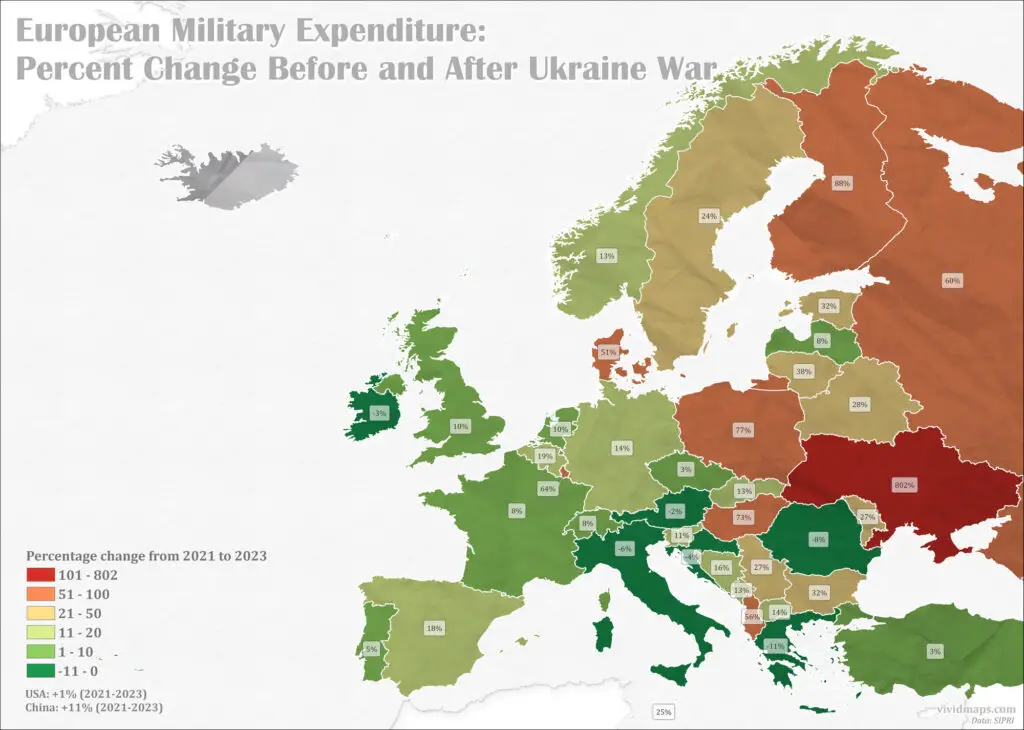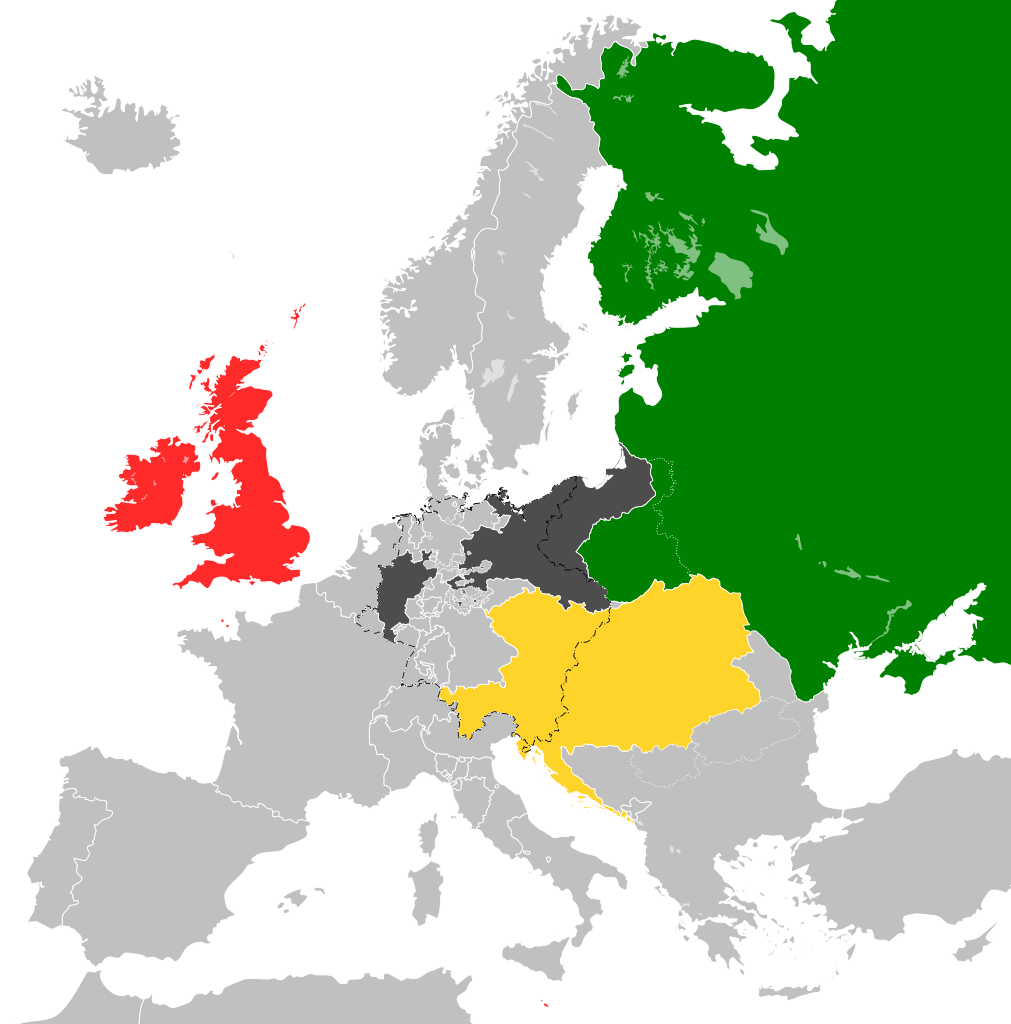European Military Spending Shifts: Mapping Changes from Pre-War 2021 to Post-Invasion 2023
In light of the ongoing conflict in Ukraine, I’ve created a revealing map of Europe showcasing the changes in military expenditure between 2021 (the year before the war began) and 2023 (the year following the invasion). This visual representation offers a unique perspective on how European nations have responded to the dramatic shift in the continent’s security landscape.
The map of Europe below illustrates the percentage change in European Military Expenditure from 2021 to 2023. Drawing from data provided by the Stockholm International Peace Research Institute, it paints a vivid picture of the continent’s evolving defense priorities.

Digging deeper into the numbers, I’ve compiled a table comparing military spending in constant 2022 USD for 2021 and 2023. The results are eye-opening, with Ukraine unsurprisingly leading the pack with a staggering 802% increase.
| Rank | Country | 2021 Spend in Billion USD | 2023 Spend in Billion USD | % Change |
| 1 | Ukraine | 6.88 | 62.08 | +802 |
| 2 | Finland | 3.65 | 6.85 | +88 |
| 3 | Poland | 15.15 | 26.78 | +77 |
| 4 | Hungary | 2.25 | 3.88 | +73 |
| 5 | Luxembourg | 0.38 | 0.63 | +64 |
| 6 | Russia | 79.08 | 126.47 | +60 |
| 7 | Kosovo | 0.08 | 0.12 | +57 |
| 8 | Albania | 0.22 | 0.34 | +56 |
| 9 | Denmark | 5.05 | 7.62 | +51 |
| 10 | Armenia | 0.78 | 1.15 | +48 |
| 11 | Lithuania | 1.39 | 1.92 | +38 |
| 12 | Bulgaria | 1.31 | 1.72 | +32 |
| 13 | Estonia | 0.79 | 1.05 | +32 |
| 14 | Belarus | 0.97 | 1.25 | +28 |
| 15 | Serbia | 1.46 | 1.84 | +27 |
| 16 | Moldova | 0.06 | 0.08 | +27 |
| 17 | Malta | 0.08 | 0.1 | +25 |
| 18 | Sweden | 6.97 | 8.62 | +24 |
| 19 | Belgium | 6.08 | 7.25 | +19 |
| 20 | Georgia | 0.37 | 0.44 | +19 |
| 21 | Spain | 18.84 | 22.29 | +18 |
| 22 | Bosnia and Herzegovina | 0.17 | 0.2 | +16 |
| 23 | Germany | 53.72 | 61.19 | +14 |
| 24 | North Macedonia | 0.21 | 0.24 | +14 |
| 25 | Norway | 7.98 | 9.01 | +13 |
| 26 | Slovakia | 2.07 | 2.34 | +13 |
| 27 | Montenegro | 0.09 | 0.1 | +13 |
| 28 | Slovenia | 0.74 | 0.82 | +11 |
| 29 | United Kingdom | 63.01 | 69.15 | +10 |
| 30 | Netherlands | 14.08 | 15.56 | +10 |
| 31 | France | 53.01 | 57.12 | +8 |
| 32 | Switzerland | 5.4 | 5.82 | +8 |
| 33 | Latvia | 0.86 | 0.93 | +8 |
| 34 | Portugal | 3.72 | 3.9 | +5 |
| 35 | Azerbaijan | 3.08 | 3.23 | +5 |
| 36 | Türkiye | 14.32 | 14.74 | +3 |
| 37 | Czechia | 4.21 | 4.33 | +3 |
| 38 | Austria | 4.05 | 3.98 | -2 |
| 39 | Ireland | 1.22 | 1.17 | -3 |
| 40 | Cyprus | 0.52 | 0.51 | -3 |
| 41 | Croatia | 1.34 | 1.29 | -4 |
| 42 | Italy | 34.87 | 32.63 | -6 |
| 43 | Romania | 5.35 | 4.94 | -8 |
| 44 | Greece | 8.09 | 7.23 | -11 |
| 45 | Kazakhstan | 1.71 | 1.06 | -38 |
Some key observations from the European landscape:
- Nordic Boost: Finland stands out with an 88% increase, reflecting growing concerns in the Baltic region.
- Eastern European Surge: Poland (77%) and Hungary (73%) have significantly ramped up their military budgets.
- Western Europe’s Measured Response: Countries like France (8%), Germany (14%), and the UK (10%) show more modest increases.
- Outliers: A few nations, including Italy (-6%) and Greece (-11%), have actually decreased their military spending.
For context, it’s worth noting that major global powers outside Europe have seen less dramatic changes. The US Department of Defense’s budget rose from $871 billion in 2021 to $880 billion in 2024, a mere 1% increase. China’s defense budget grew from $280 billion to $209 billion in the same period, representing an 11% rise.
For those interested in delving deeper into European geopolitics and military history, I recommend the following resources:
- “The New Map: Energy, Climate, and the Clash of Nations” by Daniel Yergin
- “Prisoners of Geography: Ten Maps That Explain Everything About the World” by Tim Marshall
- “This is Not a New World Order: Europe Rediscovers Geopolitics, from Ukraine to Taiwan” by Sven Biscop
As the situation continues to evolve, this map of Europe serves as a crucial tool for understanding the complex interplay of security, economics, and geopolitics shaping the continent’s future.








